Small businesses are the lifeblood of every local community in the United States. They represent 99.9% of American firms. Yet, effectively financing these 33+ million SMBs is an ongoing challenge to financial institutions, which creates challenges to the prosperity of your local community.
Small businesses can be inherently risky, and some end up being short-lived operations. And while the demand for innovative lending solutions tailored for SMBs continues to grow, traditional lenders, particularly traditional financial institutions such as credit unions, frequently view SMB lending as resource-intensive and unprofitable due to the current manual nature of it. As a result, they shy away from the space.
But credit unions can’t continue to turn a blind eye to what is going on in the very communities they exist to serve — not if they want to remain relevant. According to the U.S. Census Bureau, almost 5.5 million new business applications were filed in 2023, breaking the 2021 record of 5.4 million. Since 2012, the submission rate for new business applications has more than doubled and approximately 5 million new business are added every year.
Currently only 42% of small businesses have their financing needs met, illustrating a significant gap in financial services for these businesses. The majority of SMBs rely on either a large or small bank or online lender as their financial services provider. This heavy reliance on banks and online lenders could be due to a lack of knowledge of other financing options, such as alternative lenders, angel investors, or, more importantly, credit unions! This is resulting in more than hundreds of billions of dollars in unmet capital needs and predatory interest rates from online lenders.
In April 2025, ondeck.com shows its average term loan interest rate to be 57.9% with up to a 4% origination fee. Those rates are excessive, and credit unions can provide a better experience.

Start With The Community Relationship And Work Backward
The competitive differentiation of credit unions over large banks, online lenders, and finance companies is rooted in the member relationship and localized field of memberships.
For credit unions to continue to succeed, they must know their communities best. They must tailor their products to meet the exact needs of members. The core of the credit union business model — people helping people — is reliant on their members explicitly choosing to continue working with them.
Given this, credit unions should never view the small business lending opportunity solely as a revenue driver.
Instead, they need to view it as a mechanism for protecting and strengthening their community relevance and relationships. They need to view it as an opportunity to uncover unmet needs that can inform both their strategy and product roadmaps and to build trust and brand affinity when they help their local community successfully navigate the volatility that is inherent in running a small business.
Put simply, if you’re going to build an SMB lending business within a local credit union, you should start with the community relationship, connecting with local SMBs and work backward.
When SMBs thrive, communities thrive. When communities thrive, credit unions thrive!
The Importance Of Embracing Digital Innovation
To fully seize the SMB lending opportunity, credit unions must embrace digital transformation where the frictionless member experience is the priority underpinned by the power of real-time data and digital efficiency.
As technology continues to evolve and industries become more specialized, the ability to leverage technology and data to swiftly understand and meet the unique needs of small businesses will be a key differentiator.
The cost of manual underwriting and processing loans for small businesses is relatively high compared to the loan amounts. For traditional financial institutions, this means lower profitability per loan, often disincentivizing them from focusing on the small business segment.
Embracing a digital first approach allows lenders to offer SMBs frictionless access to financial products that meet their specific needs. Digital application, underwriting and origination might be followed by flexible repayment terms, working capital loans that align with seasonal cash flows, or financing options that take into account the growth trajectory of a startup. Such tailored solutions can significantly improve the likelihood of a business succeeding and repaying its loan.
And if small businesses are the engine of your local economy, then capital from your credit union is their fuel. Community prosperity awaits.

Ranqx empowers financial institutions to generate growth, increase profitability, and strengthen member relationships with its SaaS based SMB lending platform. It delivers the industry’s fully digital, cloud-based solution for small business lending and members will go from application to recommended decision in as little as five minutes.